Let me whisk you away to a place where the Italian Alps stand guard over a town steeped in history, culture, and mouth-watering cuisine—welcome to Aosta, a hidden gem that feels like a scene straight out of a fairy tale.
Imagine walking on streets that echo the footsteps of Roman legions. Aosta, or Augusta Praetoria as it was known, opens its ancient arms to those who love to unravel history. The Arch of Augustus, standing as a gateway to the past, and the whispering ruins of the Roman Theater invite you into a world where history isn’t just learned; it’s felt.
The Heartbeat of Aosta: Piazza Chanoux
Strolling through Aosta, you’ll inevitably find yourself in Piazza Chanoux, the pulsating heart of the town. It’s more than just a square; it’s a living room where locals catch up over a cup of coffee, and travelers can soak in the laid-back Italian vibe. The air is filled with lively chatter, the aroma of freshly brewed espresso, and the inviting scents wafting from nearby restaurants.
As the sun dips behind the Alps, Aosta reveals another layer of its charm—its cuisine. Dive into dishes that warm the soul and delight the senses, like the creamy Fontina cheese fondue or the rustic simplicity of polenta. And the wine? Let’s just say the vineyards around Aosta don’t play second fiddle to anyone.
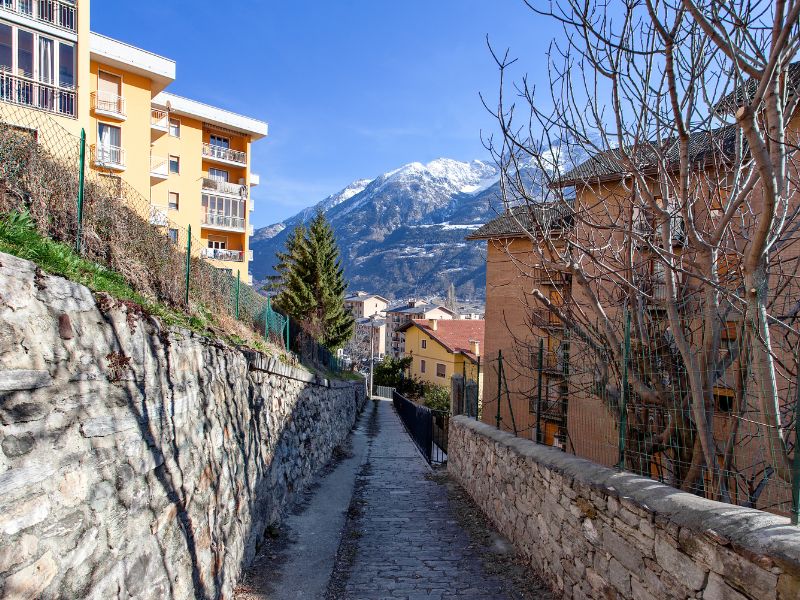
Adventure Awaits
For the thrill-seekers and nature lovers, Aosta is your launchpad to the wild playground of the Aosta Valley. Whether it’s skiing the world-renowned slopes of Cervinia, hiking through the breathtaking trails of Gran Paradiso National Park, or simply finding your peace by a hidden alpine lake, adventure here is as vast as the sky.
But it’s not just the grand adventures that make Aosta special. It’s the small moments—the warmth of a local greeting, the unexpected beauty of a medieval church tucked away in a quiet corner, or the surprise of stumbling upon a Roman relic in the middle of a modern city.
The Enchanting World of Aosta
Aosta, with its blend of awe-inspiring nature, deep-rooted history, and the irresistible allure of Italian culture, invites you on a journey that promises to be nothing short of magical. Whether you’re drawn to the echoes of the past, the call of the wild, or the joy of savoring life one bite at a time, Aosta is a place where memories are made and the soul is nourished.
So, pack your bags, and set your compass to Aosta. A world of discovery awaits, where every path leads to wonder, every meal is a celebration, and every moment is a treasure. Ready to fall in love with Aosta? I promise, it’s an place to remember.
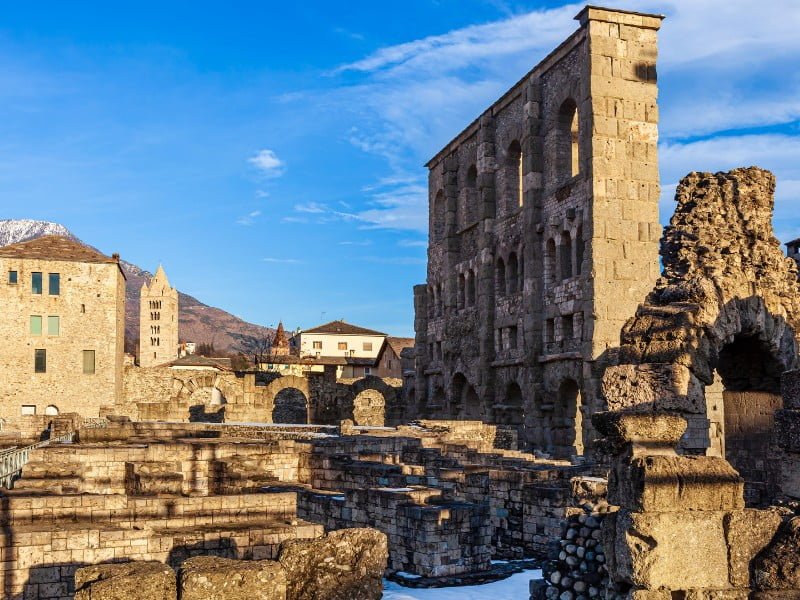
Aosta City Guide: A Brief History Of Aosta, Italy
Let’s journey through time to uncover the layers of history that make Aosta a fascinating destination for history buffs and casual explorers alike.
The Roman Footprint
Founded by the Romans in 25 BC as Augusta Praetoria Salassorum, Aosta was a strategic military settlement designed to control the passes through the Alps. Today, the city is an open-air museum boasting some of the best-preserved Roman ruins in the Alps, including a magnificent triumphal arch, the Praetoria Gate, and a remarkable theatre that once seated thousands. Strolling through the city, you’re walking on the same ground where Roman citizens, soldiers, and perhaps even emperors once tread. It’s like stepping back into a time when Aosta was a bustling Roman outpost, guarding the empire’s northern frontier.
Medieval Majesty
As the Roman Empire faded, Aosta found itself at the crossroads of history once again, this time in the Middle Ages. The city became a key bishopric, and powerful lords built castles and fortresses that dot the landscape to this day. The Cathedral of Santa Maria Assunta and San Giovanni Battista, with its fascinating blend of Romanesque and Gothic architecture, showcases the city’s medieval religious significance. Exploring Aosta’s medieval heritage feels like wandering through a storybook, with each turn revealing tales of knights, pilgrims, and intrigue.
A Renaissance Rebirth
Though less known for its Renaissance period, Aosta quietly flourished, leaving behind subtle yet beautiful marks of this era. The city’s layout began to evolve, opening up from its medieval confines, and elegant palaces were erected, hinting at the wealth and artistry of the time. The Renaissance brought a period of artistic and architectural refinement to Aosta, further enriching its already diverse historical landscape.
The Alpine Crossroads
Beyond its Roman and medieval past, Aosta’s location has made it a melting pot of cultures. Situated at the crossroads of Italy, France, and Switzerland, the city has been influenced by the passage of various peoples, languages, and traditions throughout the centuries. This unique blend is evident in the local cuisine, festivals, and everyday life, making Aosta not just a historical gem but also a cultural one.
Aosta Today: Where Ancient Meets Modern
Modern Aosta is a city proud of its heritage, where ancient ruins stand alongside contemporary buildings in harmony. The annual Sant’Orso Fair, a tradition that dates back over a thousand years, brings artisans from across the Alps to showcase their crafts, just as they might have in medieval times. Yet, Aosta is also a modern city, with lively cafes, excellent restaurants, and boutique shops offering a contemporary twist on Alpine life.
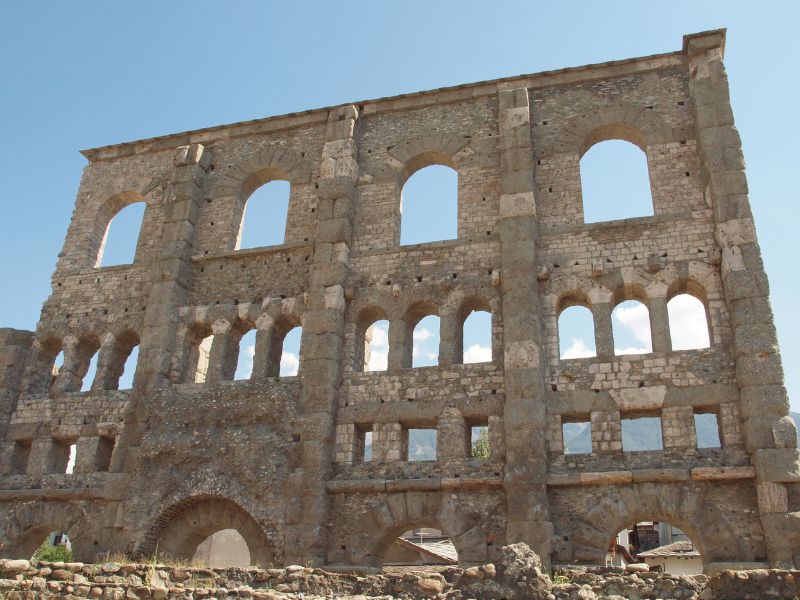
Aosta Top Attractions and Best Places to Visit in Italy
Located in a high mountain valley in Northwestern Italy, the small city of Aosta was once an important military outpost for the Romans. Today, its past heritage is one of its biggest attractions, as is its mountain surroundings. Because of this, history buffs and nature lovers alike will enjoy spending 2-3 days in this lesser-known destination.
Make the Criptoportico Forense your first stop in Aosta. There are several noteworthy Roman remnants in the city, but this covered alcove stands out. Nobody knows what the Criptoportico was used for, but experts speculate it served as a market during the winter months.
But if you love ruins, it won’t matter, as this 2,000-year-old gem gives your imagination room to run. Like the other Roman sites in this city, you’ll need a ticket to enter. For 7 EUR, you’ll gain admission to this amazing place. Sadly, this attraction is unsuitable for wheelchair-bound visitors.
More Attractions
Next, pay a visit to the Teatro Romano. While the complex is open ruins today, historians believe this structure once had a roof. During the reign of Emperor Claudius, this theatre started hosting cultural events for local residents.
After falling prey to scavengers and the elements for more than 1,500 years, Teatro Romano is once again hosting shows. Check with local authorities, and you may be able to catch a performance.
Want to learn more about the history of Aosta? Check out the exhibits at Museo Archeologico Regionale. Here, you’ll get to see artifacts that pre-date the Roman Empire, as well as scores of items from Roman times.
In this institution’s collection, you’ll find pottery, ancient glass, funeral implements, and much more. However, as good as this hidden gem is, many captions are in Italian only. To get around this, use Google Translate or bring an Italian-speaking friend.
While in Aosta, church lovers will want to visit Collegiata dei Santi Pietro e Orso. This humble house of worship may be small, but it dates back to the 9th century. Within, you’ll find loads of cool artifacts, as well as Romanesque paintings that illustrate how old this church really is.

Other Cultural Attractions: Trip to Aosta, Italy
Aosta has a rich history, but the nature surrounding it is just as impressive. Make time for a day trip to Parco Nazionale Gran Paradiso during your visit. From dense valley forests to chilly glaciers, its landscapes vary greatly.
As you make your way through the park, keep your eyes open for wildlife. In particular, the alpine ibex, alpine chamois, marmots stand out. In any season, this park offers amazing vistas – do not miss it.
Up for more time in the outdoors? Then work Mont Avic Natural Park into your schedule. Unlike Gran Paradiso, this park had been home to humans before its establishment in 1989. In that time, however, nature has reclaimed the land, leaving only faint traces of habitation.
Other Attractions
In this park, there are loads of trails that lead to alpine lakes and amazing sights. After several hours of hiking, a rest house at the park gates awaits with food and refreshments.
Back in Aosta, be sure to walk through Porta Pretoria. This ancient stone gate dates back to the Roman Empire, when it was one of several entryways through the city wall. After taking a selfie with this landmark, have a coffee at one of the coffee shops nearby.
Relax on your final day at this destination by spending an evening in Aosta Old Town. Planners have pedestrianized most of its streets, making it easy to take in all the sights. After you’ve finished sightseeing, there are plenty of shops, cafes, restaurants, and bars to experience.
Visiting in the winter season? In the centre of Aosta, you’ll find their annual Christmas Market. As you check out the crafts, don’t forget to try some grappa – their answer to Germany’s gluhwein.
source: Expat Essentials For Italy on YouTube
Top 20 Things To Do in Aosta, Italy For Visitors
Here’s your ultimate guide to the top 20 things to do in Aosta, ensuring a journey filled with discovery and wonder.
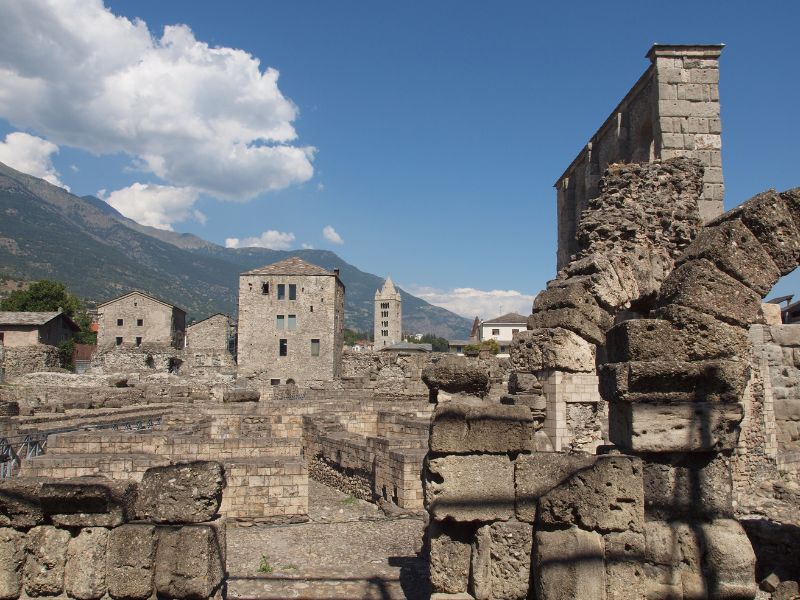
1. Visit the Roman Theatre
The Roman Theatre of Aosta is an ancient marvel, with its monumental façade still standing tall. Visitors can wander through the ruins and imagine the grand performances once held here. Summer often brings live performances, breathing life back into the stone amphitheater. It’s not only a symbol of Aosta’s Roman heritage but also a fantastic spot for photography, particularly at dusk when the soft light illuminates the ruins.
- Best for: History buffs and photographers.
- Tip: Attend a summer performance if possible.
- Highlight: Imposing façade and well-preserved ruins.
2. Explore the Arch of Augustus
The Arch of Augustus, built in 25 BC, marks the Roman victory over the Salassi tribe and stands as one of Aosta’s most iconic symbols. This well-preserved Roman arch is a beautiful starting point for any exploration of the city’s ancient past. Framed against the backdrop of the old town, it’s especially captivating at night when it’s illuminated.
- Best for: History lovers and photographers.
- Tip: Visit at night for a beautifully lit view.
- Highlight: Ancient Roman arch at the city’s entrance.
3. Wander Through Aosta’s Old Town
Aosta’s Old Town is a charming maze of cobblestone streets, historical buildings, and quaint squares. This medieval quarter is full of boutiques, cafes, and restaurants where you can pause for an espresso or some regional cuisine. Key highlights include the Collegiate Church of Saint Orso, a peaceful retreat known for its intricate cloisters. It’s an ideal place for a leisurely stroll.
- Best for: Strolling and cultural immersion.
- Tip: Visit the cloisters of Saint Orso for a tranquil experience.
- Highlight: A delightful mix of medieval architecture and local life.
4. Visit the Aosta Cathedral
The Aosta Cathedral, with its Romanesque and Gothic features, stands proudly as a significant piece of the city’s history. Inside, visitors can admire the stunning frescoes, religious artifacts, and the unique crypt with ancient inscriptions. Whether you’re attending mass or simply exploring, the cathedral’s spiritual and architectural beauty, framed by the Alps, makes for an unforgettable visit.
- Best for: Architecture and history enthusiasts.
- Tip: Explore the crypt to uncover ancient Christian relics.
- Highlight: Fascinating mix of Romanesque and Gothic elements.
5. Take the Skyway Monte Bianco
Though not within Aosta itself, the Skyway Monte Bianco is a must-do adventure just a short journey away. This cutting-edge cable car whisks visitors up to Punta Helbronner, offering breathtaking 360-degree views of the Italian, Swiss, and French Alps. At the summit, you can enjoy panoramic terraces and even some light hiking. It’s an awe-inspiring experience for nature lovers.
- Best for: Adventurers and nature lovers.
- Tip: Dress warmly, even in summer, as it’s chilly at higher altitudes.
- Highlight: Panoramic views of the Mont Blanc massif.
6. Explore the Sant’Orso Fair
Held every January, the Sant’Orso Fair is a traditional artisan festival with over a thousand years of history. Here, local craftsmen showcase their talents, offering woodcarvings, textiles, and handmade goods. The fair is a celebration of Val d’Aosta’s rich cultural heritage, complemented by street performers, traditional music, and local food. The vibrant atmosphere makes it a winter highlight.
- Best for: Artisans and culture enthusiasts.
- Tip: Bring cash to purchase handmade crafts.
- Highlight: Over a thousand years of history, with vibrant local art.
7. Hike in Gran Paradiso National Park
Just a short drive from Aosta, Gran Paradiso National Park offers breathtaking alpine scenery and trails for all levels of hikers. Known for its diverse wildlife, including ibex and marmots, the park’s serene valleys and rugged peaks make it a paradise for nature lovers. Guided tours provide insights into the rich flora and fauna, making it both an educational and exhilarating outdoor adventure.
- Best for: Hikers and wildlife enthusiasts.
- Tip: Pack binoculars for better wildlife sightings.
- Highlight: Stunning alpine landscapes with abundant wildlife.
8. Relax at Pré-Saint-Didier Spa
For a tranquil retreat, the Pré-Saint-Didier Spa offers an idyllic setting to unwind. Surrounded by the beauty of the Mont Blanc range, this luxurious spa features thermal baths, saunas, and relaxation areas. The outdoor pools are particularly magical in the winter months, where you can enjoy the warm water while gazing at the snowy peaks.
- Best for: Those in need of relaxation.
- Tip: Visit in the evening for a peaceful soak under the stars.
- Highlight: Breathtaking views of Mont Blanc from the thermal baths.
9. Tour the Castles of the Aosta Valley
The Aosta Valley is home to a number of enchanting castles, including Fénis Castle, known for its medieval architecture and frescoes. Another must-see is Fort Bard, a majestic stronghold now serving as an arts and museum complex. For panoramic views, visit the ruins of Châtel-Argent, which overlook the surrounding landscape. Touring these castles is like stepping back in time.
- Best for: History and architecture lovers.
- Tip: Fort Bard often hosts fascinating exhibitions.
- Highlight: Well-preserved medieval castles with rich histories.
10. Attend the Battle of the Queens
A unique and traditional event in the Aosta Valley, the Battle of the Queens showcases cow fighting, a practice where cows naturally compete for dominance. These gentle contests are non-violent, showcasing the cows’ strength and role in local agriculture. Held in various locations throughout the valley, it’s an authentic glimpse into the region’s agricultural traditions.
- Best for: Cultural explorers and agricultural enthusiasts.
- Tip: Arrive early to secure a good viewing spot.
- Highlight: Unique agricultural tradition with strong community ties.
11. Ski at Pila Ski Resort
Pila Ski Resort, a short cable car ride from Aosta, is a popular destination for skiing and snowboarding enthusiasts. Known for its well-maintained slopes and stunning views of the Italian Alps, the resort caters to all levels of skiers. In addition to skiing, Pila offers snowboarding parks, scenic restaurants, and après-ski options. With consistent sunshine and great snow conditions, it’s a favorite spot for both locals and visitors alike.
- Best for: Skiers and snowboarders of all levels.
- Tip: Visit the top for breathtaking views of Mont Blanc.
- Highlight: Sunny slopes with views of the Alps.
12. Visit the Roman Bridge of Pont d’Aël
The Pont d’Aël is a Roman aqueduct bridge located in a village near Aosta, dating back to 3 BC. It stretches across a dramatic gorge and showcases ancient Roman engineering at its finest. Visitors can walk through the aqueduct’s path while enjoying stunning views of the surrounding landscapes. The bridge is surrounded by scenic hiking trails, making it a perfect stop for history lovers and outdoor enthusiasts.
- Best for: History buffs and hikers.
- Tip: Explore the surrounding trails for a scenic hike.
- Highlight: A well-preserved Roman aqueduct bridge with breathtaking views.
13. Participate in a Wine Tasting Tour
The Aosta Valley is home to unique, high-altitude vineyards that produce distinctive wines such as Petit Rouge and Fumin. A wine tasting tour offers visitors a chance to explore local wineries, learn about the region’s winemaking process, and sample a variety of fine wines. Many wineries also pair their wines with regional dishes, enhancing the experience with a taste of local cuisine.
- Best for: Wine lovers and food enthusiasts.
- Tip: Opt for a tour that includes a vineyard walk and a paired meal.
- Highlight: High-altitude wines paired with traditional Aosta Valley cuisine.
14. Climb at the Aosta Climbing Gym
For those looking for indoor adventure, the Aosta Climbing Gym provides a challenging and fun environment for climbers of all levels. With well-designed walls for bouldering and top-rope climbing, it’s perfect for beginners learning the ropes or experienced climbers looking to refine their skills. Professional instructors are available, and the gym frequently hosts competitions and workshops.
- Best for: Climbers of all skill levels.
- Tip: Check the schedule for upcoming workshops or competitions.
- Highlight: A safe, indoor space for climbing enthusiasts.
15. Explore the Local Markets
Aosta’s local markets, held weekly, are a must-visit for those looking to discover the region’s finest produce, cheeses, and artisan crafts. The Wednesday market in Piazza Chanoux is particularly vibrant, offering everything from fresh fruit to handmade textiles. Take your time browsing the stalls and chatting with local vendors about their goods. Be sure to try Fontina cheese, one of the valley’s culinary specialties.
- Best for: Foodies and shoppers.
- Tip: Sample local cheese and meats for a true taste of Aosta.
- Highlight: A lively market atmosphere with regional delicacies and crafts.
16. Mountain Biking in the Alps
The Aosta Valley is a haven for mountain biking, with its diverse range of trails that offer something for all levels. From scenic, gentle routes through alpine meadows to adrenaline-pumping downhill tracks, biking here allows you to experience the beauty of the Alps from a unique perspective. Rentals and guided tours are available, making it easy to explore the valley on two wheels.
- Best for: Adventure seekers and outdoor lovers.
- Tip: Try the trails near Pila for a mix of scenic and challenging paths.
- Highlight: Stunning views and exhilarating bike trails.
17. Visit the Megalithic Area of Saint-Martin-de-Corléans
The Megalithic Area of Saint-Martin-de-Corléans is one of Italy’s most significant prehistoric archaeological sites, offering insights into 5,000 years of history. The site features standing stones, burial sites, and ancient tools, which provide a fascinating glimpse into the lives of the valley’s prehistoric inhabitants. A modern museum on-site interprets these ancient findings, making it a must-visit for history and archaeology enthusiasts.
- Best for: History buffs and archaeology enthusiasts.
- Tip: Take a guided tour to fully appreciate the site’s historical importance.
- Highlight: Ancient megaliths and burial sites dating back over 5,000 years.
18. Attend the Music Festivals
Throughout the year, Aosta hosts a variety of music festivals, featuring genres such as classical, jazz, and folk. Many of these performances take place in stunning historic settings or scenic outdoor venues, adding to the overall experience. Attending one of these festivals is a wonderful way to soak in both local and international talent while enjoying the cultural vibrancy of the city.
- Best for: Music lovers and culture seekers.
- Tip: Check the local calendar for upcoming performances.
- Highlight: A mix of local and international music in picturesque settings.
19. Relax at the Public Gardens
The public gardens of Aosta offer a peaceful escape within the city, perfect for a quiet afternoon or a scenic picnic. These well-manicured gardens feature flower beds, fountains, and plenty of shady spots for relaxation. Stroll along the pathways or sit by the benches to enjoy the Alpine air and views of the surrounding mountains.
- Best for: Nature lovers and families.
- Tip: Bring a picnic and spend a lazy afternoon in the gardens.
- Highlight: Beautifully landscaped spaces with views of the Alps.
20. Learn at the Observatory of the Aosta Valley
For astronomy lovers, the Observatory of the Aosta Valley offers the chance to gaze at the stars through high-powered telescopes. Located away from the city lights, it provides an excellent environment for stargazing. The observatory also hosts workshops and lectures, making it a fantastic educational outing for families or anyone interested in the mysteries of the cosmos.
- Best for: Stargazers and science enthusiasts.
- Tip: Visit on a clear night for the best stargazing experience.
- Highlight: Public observations and astronomy workshops in a pristine mountain setting.

What To Eat and Drink in Aosta, Italy
Feeling a hunger pang come on as you explore Aosta? Fill the void with a Crespelle alla Valdostana. This savoury treat is a crepe that is stuffed with Fontina cheese, ham, and mushrooms. Topped with béchamel sauce, it almost feels too fancy to be a snack.
At dinner time, find a restaurant that serves Carbonade Valdostana. This rich stew, which contains ingredients like cubed beef, onions, and red wine, simmers for hours on end. When it finally makes its way to your table, you’ll be in for a treat – come hungry.
If you have room left for dessert, visit a bakery that sells Tegole Valdostane. These are thin cookies that contain almonds, hazelnuts, vanilla extract, and lots of sugar. If you don’t have them after dinner, try these biscuits with one of your coffee breaks in Aosta.
Here’s a comprehensive guide to what you should eat and drink while in Aosta, Italy, to truly savor the flavors of this alpine region.
Must-Try Foods
1. Fonduta
A creamy fondue made with Fontina cheese, a specialty of the region. It’s often served with crusty bread or vegetables for dipping, making for a cozy, communal dining experience.
2. Carbonada
A hearty stew traditionally made with beef slow-cooked in red wine with onions, spices, and sometimes with the addition of cinnamon or cloves for an extra layer of flavor. It’s usually served with polenta.
3. Polenta Concia
Polenta, a staple of Northern Italian cuisine, takes a special form in Aosta. It is rich and creamy, mixed with Fontina cheese and butter, often accompanied by meat or mushroom sauces.
4. Lardo di Arnad
A delicacy from the nearby village of Arnad, lardo di Arnad is a type of seasoned and cured pork fatback. It’s thinly sliced and often served with traditional black bread as a starter.
5. Tegole
These are thin, crunchy biscuits named after roof tiles (tegole) because of their shape. Made with almonds and hazelnuts, they’re a sweet treat not to be missed.
6. Valle d’Aosta Jambon de Bosses
A DOP-protected, air-dried ham that’s seasoned with mountain herbs, giving it a distinctive flavor. Enjoy it as part of an antipasti platter.
7. Civet de Chamois
A gamey stew made from chamois, a type of mountain goat-antelope native to the Alps. The meat is marinated in wine and spices before being slow-cooked.
8. Seupa à la Vapelenentse
A traditional soup made from cabbage, Fontina cheese, bread, and beef stock. It’s a comforting dish, perfect for the cold mountain weather.
Must-Try Drinks
9. Genepy
A herbal liqueur made from the Alpine genepy herb. It’s often enjoyed as a digestif and is believed to have medicinal properties.
10. Valle d’Aosta DOC Wines
The Aosta Valley produces exquisite wines, despite its small size. Don’t miss trying local varietals like Petit Rouge or Fumin, which reflect the unique terroir of the region.
11. Hot Chocolate
Given the region’s proximity to Switzerland, it’s no surprise that hot chocolate here is thick, rich, and utterly indulgent—perfect for warming up after a day in the snow.
12. Caffè alla Valdostana
A unique way to enjoy coffee in Aosta, this is a concoction of coffee, grappa, genepy, and sugar, all set aflame before serving. It’s not just a drink but a spectacle.

Top Restaurants In Aosta, Italy
Here’s a list of top restaurants in Aosta, Italy, where you can indulge in the region’s gastronomic delights.
1. Osteria dell’Oca
Located in the historic center of Aosta, Osteria dell’Oca is renowned for its authentic Valdostan dishes, cozy ambiance, and excellent wine selection. It’s the perfect spot to try regional specialties like carbonada and polenta concia.
2. Trattoria Praetoria
Offering a warm welcome and a menu brimming with local flavors, Trattoria Praetoria specializes in traditional recipes with a modern twist. Don’t miss their fonduta, served with a variety of accompaniments.
3. La Bottega Degli Antichi Sapori – À La Table du Sommelier
This restaurant and wine bar serves exquisite dishes paired with the perfect wine. The sommelier’s expertise elevates the dining experience, making it ideal for oenophiles and foodies alike.
4. Ristorante Vecchio Ristoro
A favorite among locals and visitors, Vecchio Ristoro offers a refined menu in an elegant setting. The chef’s creativity shines through in every dish, from starters to desserts, all sourced from the best local ingredients.
5. Hostaria del Calvino
For a lively atmosphere and rustic, hearty meals, Hostaria del Calvino is a must-visit. Their menu features a range of Valdostan and Italian dishes, with the house-made pasta being a standout.
6. HB Aosta Hotel – Brasserie Café D’Europe
Located within the HB Aosta Hotel, this brasserie offers a contemporary dining experience with both indoor and outdoor seating. The menu includes traditional Italian and Valdostan cuisine, crafted from fresh, local produce.
7. Agriturismo La Reina
Just outside Aosta, Agriturismo La Reina provides a farm-to-table experience, serving dishes made from ingredients produced on their own farm. The setting, surrounded by nature, adds to the rustic charm and authenticity of the meal.
8. Le Petit Restaurant
This intimate restaurant is known for its attention to detail and a menu that combines local traditions with international influences. Each dish is beautifully presented, making every meal a feast for the eyes as well as the palate.
9. Bataclan
Bataclan offers a unique dining experience with its eclectic decor and fusion cuisine. The menu changes seasonally, ensuring the freshest ingredients are used to create dishes that are as innovative as they are delicious.
10. Petit Bijou
Nestled in the mountains near Aosta, Petit Bijou is a gem worth discovering. Specializing in local cuisine, the restaurant’s ambiance is matched by the quality of its dishes, making it the perfect spot for a romantic dinner or a special celebration.
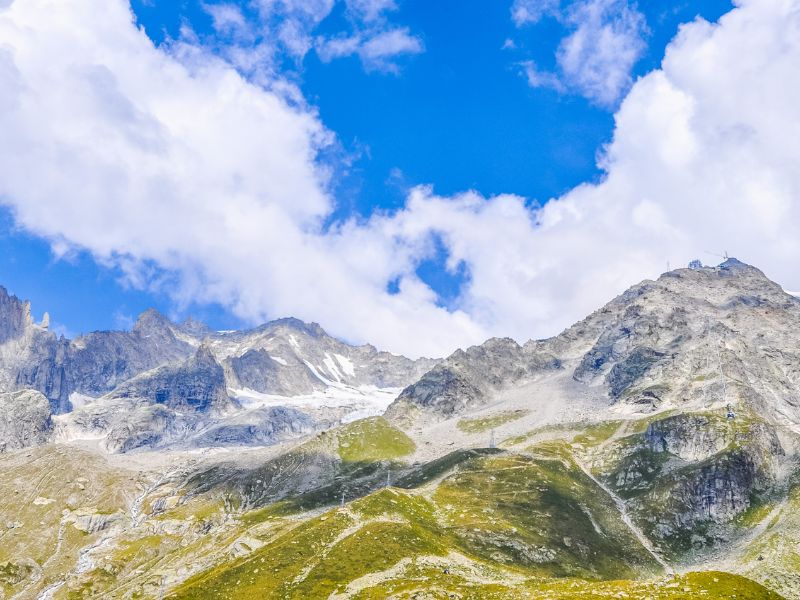
Tours For Visitors To Aosta, Italy
Here’s a list of curated experiences to immerse yourself in the beauty and heritage of this ancient Alpine city.
1. Ancient Roman Aosta Guided Tour
Delve into Aosta’s Roman past with a guided tour of its ancient sites, including the remarkably preserved Roman Theatre, the Arch of Augustus, and the Praetoria Gate. Learn about the strategic importance of Aosta in the Roman Empire and marvel at the engineering prowess of ancient architects. This tour is perfect for history buffs looking to step back in time.
2. Medieval Castles of the Aosta Valley
Explore the numerous castles and fortresses dotting the Aosta Valley on a guided tour that takes you through centuries of medieval history. Visit the Fénis Castle, known for its stunning frescoes and intricate architecture, and the imposing Bard Fortress, which offers breathtaking views of the valley. Each castle tells a story of feudal lords, battles, and the art of fortification.
3. Aosta Culinary and Wine Tasting Tour
Savor the flavors of the Aosta Valley with a culinary tour that introduces you to local delicacies like Fontina cheese, Jambon de Bosses, and Valle d’Aosta Lard d’Arnad. Visit traditional vineyards to taste exquisite wines unique to the region, such as Petit Rouge and Fumin. This tour is a feast for the senses, combining gastronomic delights with scenic beauty.
4. Aosta Art and Architecture Walking Tour
Discover Aosta’s artistic treasures on a walking tour that highlights its Romanesque and Gothic architecture. Visit the Aosta Cathedral and Sant’Orso Church, with their beautiful frescoes and intricate carvings. Learn about the city’s evolution from ancient times through the Middle Ages to modern day, and the artistic legacy left by each era.
5. Hiking Tour of Gran Paradiso National Park
Just a stone’s throw from Aosta, embark on a guided hiking tour of Gran Paradiso National Park, Italy’s oldest national park. Marvel at the stunning Alpine landscapes, spot wildlife like ibexes and marmots, and enjoy the tranquility of unspoiled nature. This tour is ideal for nature lovers and adventure seekers.
6. Monte Bianco Skyway Experience
Take a breathtaking journey on the Monte Bianco Skyway, a cable car that offers panoramic views of the Italian Alps, including Mont Blanc. At the summit, explore the botanical gardens, visit the Saussurea Alpine Botanical Garden, and dine in a restaurant with a view. This tour combines natural beauty with engineering marvels.
7. Aosta Valley Hot Air Balloon Flight
For a truly unforgettable experience, take to the skies on a hot air balloon flight over the Aosta Valley. Soar above ancient castles, rolling vineyards, and rugged mountains, all while basking in the early morning light. This tour offers a unique perspective on the valley’s breathtaking landscapes.
8. Traditional Craftsmanship Tour
Dive into the world of traditional Aosta Valley craftsmanship with a tour that visits local artisans. Witness the creation of wooden clogs (sabots), soapstone sculptures, and intricate lacework. This tour provides insight into the valley’s cultural heritage and the artisans keeping traditional crafts alive.
9. Gressoney Valley Walser Culture Tour
Explore the Gressoney Valley, home to the Walser people, a Germanic population that settled in the valley in the 12th century. Learn about their unique traditions, language, and architecture on a tour that includes visits to Walser houses, museums, and traditional alpine villages. This tour is a deep dive into the diverse cultural tapestry of the Aosta Valley.
10. Alpine Botanical Garden and Wildlife Tour
Discover the rich flora and fauna of the Aosta Valley with a tour of an Alpine botanical garden. Guided by a botanist, learn about the medicinal and culinary uses of alpine plants, and keep an eye out for the region’s wildlife. This tour is perfect for those looking to connect with the natural world in a beautiful mountain setting.
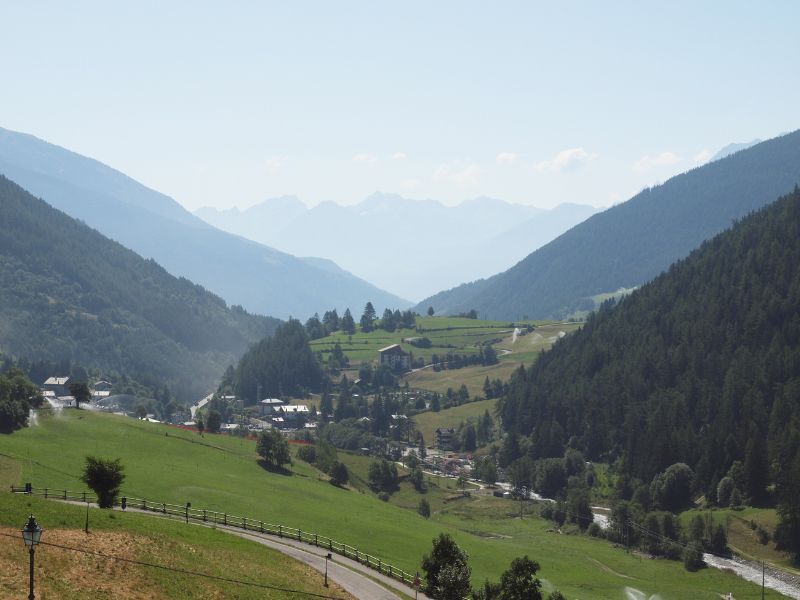
Aosta Accommodations Guide: Hotels, Guesthouses and Hostels
Here’s a travel guide to some of the best accommodations in Aosta, catering to every type of traveler.
Luxury Hotels
1. Hotel Bellevue
Situated with stunning views of the surrounding mountains, Hotel Bellevue offers luxurious rooms, a spa and wellness center, and an on-site gourmet restaurant. It’s the perfect retreat for those looking to indulge in comfort after a day of exploring Aosta Valley.
2. Hostellerie Du Cheval Blanc
This elegant hotel is located in the heart of Aosta and provides guests with spacious, modern rooms, an indoor swimming pool, and a wellness area. It’s an ideal base for visitors seeking luxury within walking distance of Aosta’s historical sites.
Mid-Range Hotels
3. HB Aosta Hotel
Featuring contemporary decor, HB Aosta Hotel is set in the city center, offering easy access to the main attractions. It boasts comfortable rooms, a sauna, and a ski storage space, making it perfect for both summer and winter visits.
4. Hotel Cecchin
A family-run hotel that blends traditional charm with modern amenities, Hotel Cecchin sits near the Roman Theatre and offers a cozy stay. With its renowned restaurant serving local Valle d’Aosta specialties, it’s a great option for food lovers.
Budget Accommodations
5. Hotel Milleluci
Overlooking Aosta, Hotel Milleluci is housed in a traditional alpine building, offering a range of comfortable rooms within a budget. It features an outdoor pool and is just a short drive from the city’s historic center.
6. Ostello Open Space
For budget-conscious travelers, Ostello Open Space provides a friendly atmosphere with both private rooms and dormitory options. It’s located close to Aosta’s train station, offering easy access to nearby skiing and hiking spots.
Guesthouses and B&Bs
7. Le Reve Charmant
This charming bed and breakfast is situated in a beautifully renovated building, offering cozy, alpine-style rooms. Le Reve Charmant is known for its warm hospitality and serves a delicious breakfast with local products.
8. Lo Teisson
Set in the picturesque village of Pollein, just outside Aosta, Lo Teisson offers comfortable rooms and a hearty breakfast, including homemade cakes and jams. It’s an excellent choice for travelers looking for a quiet retreat.
Hostels
9. Hostel Petit Prince
Offering budget-friendly accommodation with both private rooms and dormitories, Hostel Petit Prince is ideal for backpackers and young travelers. Located in the heart of Aosta, it provides a communal kitchen and a cozy lounge area.
Specialty Lodging
10. Agriturismo La Viggni de Crest
For a unique stay, this agriturismo offers beautifully furnished rooms in a rustic setting with breathtaking mountain views. Guests can enjoy homegrown produce and traditional Valle d’Aosta dishes, making it a memorable experience.
11. Quart de Lune
An eco-friendly bed and breakfast that stands out for its commitment to sustainability and organic breakfast offerings. Nestled in a quiet location with mountain views, Quart de Lune is perfect for those seeking peace and relaxation.
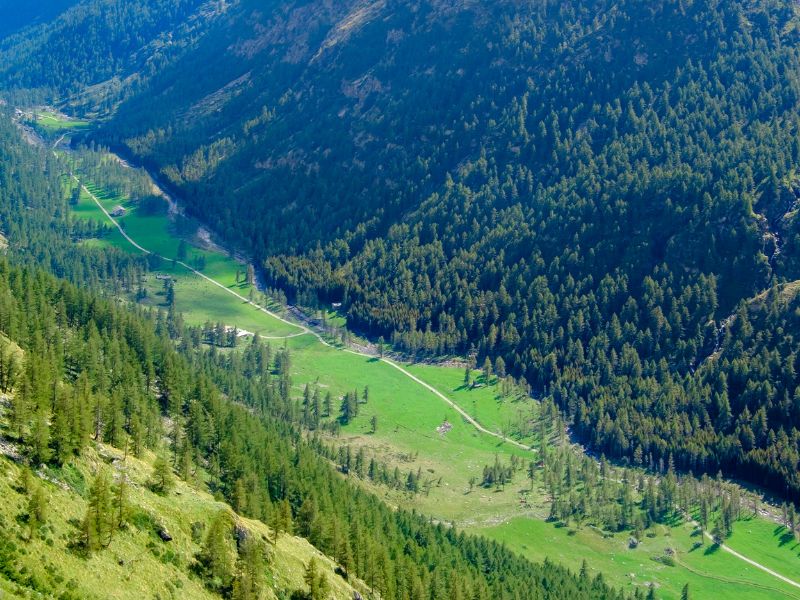
Day Trips From Aosta, Italy
Here’s a list of day trips that promise adventure, relaxation, and a deeper connection with nature and history.
1. Gran Paradiso National Park
Gran Paradiso National Park, Italy’s oldest national park, is a sanctuary of alpine beauty, offering pristine landscapes, diverse wildlife, and countless hiking trails. Spend your day trekking through lush valleys, spotting ibexes and chamois, or exploring high-altitude botanical gardens. The park’s namesake, Gran Paradiso Mountain, provides a stunning backdrop for photographers and nature lovers alike. Guided tours are available to help navigate the extensive trails and learn about the park’s conservation efforts.
2. Mont Blanc and Courmayeur
Just a drive through the Mont Blanc Tunnel, Courmayeur offers stunning views of Europe’s highest peak. This chic alpine town is a base for hiking, skiing, and enjoying Italian cuisine with a view of the majestic mountains. The Skyway Monte Bianco cable car offers a breathtaking journey to Punta Helbronner, where you can walk among the clouds with panoramic views of the Alps. Courmayeur combines adventure with luxury, making it a perfect day trip for those seeking both thrills and relaxation.
3. Chamonix, France
Cross the border into France to visit Chamonix, a legendary alpine town at the foot of Mont Blanc. Chamonix is a haven for skiers, hikers, and mountaineers, offering some of the most challenging slopes and scenic hiking trails in the world. The Aiguille du Midi cable car takes you close to the summit of Mont Blanc, offering extraordinary views. This international excursion adds a French touch to your Alpine adventure, complete with culinary delights and chic boutiques.
4. Forte di Bard
The imposing Forte di Bard is an impressive 19th-century fortress that now serves as a cultural and artistic hub. Explore the museum complex within its ancient walls, including the Museum of the Alps and temporary exhibitions. The fortress, prominently featured in the film “Avengers: Age of Ultron,” offers stunning views of the Aosta Valley. It’s a perfect blend of history, art, and architecture, making for an enriching day trip.
5. Saint Vincent and the Casino
For a change of pace, visit the town of Saint Vincent, known for its thermal baths and the Casino de la Vallée, one of the largest and most prestigious casinos in Europe. Enjoy a spa day in the thermal waters, renowned for their healing properties, followed by an evening of entertainment at the casino. Saint Vincent also offers lovely cafes and restaurants where you can savor local Valdostan cuisine. It’s an ideal trip for those looking to relax and possibly try their luck.
6. Cervinia and the Matterhorn
Travel to Cervinia, a ski resort town offering spectacular views of the Matterhorn (Monte Cervino). Here, skiing is possible even in the summer, thanks to the high-altitude glacier. Non-skiers can enjoy scenic hikes, mountain biking, or just taking in the breathtaking alpine scenery. Cervinia provides a mix of outdoor adventure and cozy mountain village charm.
7. Valle d’Ayas
Discover the picturesque Valle d’Ayas, a valley known for its beautiful landscapes, traditional Walser architecture, and excellent hiking trails. Visit the charming villages of Champoluc and Antagnod, where you can explore ancient churches and cozy up in traditional restaurants to try local dishes. The area also offers opportunities for mountain biking and horseback riding. It’s a journey into the heart of Alpine culture and natural beauty.
8. Lago di Viverone
For a more laid-back experience, head to Lago di Viverone, a serene lake nestled between the Aosta Valley and Piedmont. Enjoy water sports, sunbathing, or a leisurely boat ride on the lake’s tranquil waters. The surrounding area is dotted with vineyards where you can taste local wines and enjoy panoramic views. Lago di Viverone is an oasis of relaxation, perfect for a day of unwinding.
9. Turin
Though a bit farther afield, Turin, the capital of Piedmont, is accessible for a day trip and offers a contrast to the Alpine scenery with its rich history, baroque architecture, and vibrant cultural scene. Visit the iconic Mole Antonelliana, explore the Egyptian Museum, or savor chocolate and coffee in historic cafes. Turin combines elegance and history, making it a fascinating urban escape.
10. Castles of the Aosta Valley
Embark on a castle-hopping adventure through the Aosta Valley to explore its rich medieval heritage. Visit the iconic Fénis Castle, the picturesque Castle of Verrès, and the fortress of Bard for a journey back in time. Each castle has its own unique history and architecture, set against the stunning backdrop of the Alps. It’s a perfect day trip for history enthusiasts and romantics alike.
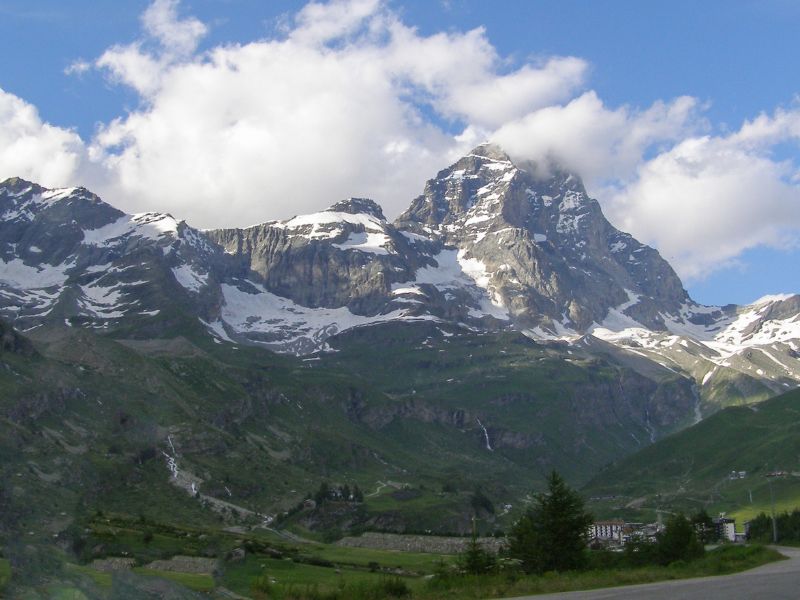
Aosta Transportation Guide
Despite its ancient roots, getting around Aosta and exploring its stunning surroundings can be surprisingly straightforward. Here’s a comprehensive guide to transportation in and around Aosta, Italy.
In the City
1. Walking
The best way to explore Aosta’s charming historic center, with its narrow streets and ancient Roman ruins, is on foot. The city is relatively compact, and most of the main attractions, including the Roman Theatre and the Arch of Augustus, are within easy walking distance of each other.
2. Bicycles
Aosta is bike-friendly, with several designated cycling paths, especially beautiful along the river. Bike rentals are available, offering a pleasant and eco-friendly way to explore the city and nearby areas.
3. Public Buses
Operated by SVAP (Società Valsesiana Autotrasporti Pubblici), the local bus service connects Aosta’s city center with surrounding neighborhoods and nearby towns. Buses are frequent and reliable, making them a convenient option for longer distances within the city or for reaching destinations just outside Aosta.
To and From Aosta
4. By Train
The Aosta railway station links the city with major towns in the Aosta Valley and further afield. Regular train services connect Aosta with Turin and other cities, providing a scenic and efficient way to travel through the region.
5. By Bus
Long-distance buses connect Aosta with major Italian cities, including Milan, Turin, and Genoa, as well as with locations in France and Switzerland. The bus station in Aosta is centrally located, making bus travel a convenient option for regional and international trips.
6. By Car
Renting a car provides the flexibility to explore Aosta and the Aosta Valley at your own pace. The city is easily accessible via the A5 motorway, which links Turin to the Mont Blanc Tunnel. Driving in the Alps can be a rewarding experience, offering unparalleled views of the mountains and valleys. However, be prepared for mountain driving conditions, especially in winter.
Exploring the Aosta Valley
7. Cable Cars and Funiculars
To fully appreciate the beauty of the Alps, take advantage of the region’s extensive network of cable cars and funiculars. These provide access to breathtaking viewpoints, hiking trails, and ski resorts, such as Pila, directly from Aosta.
8. Tour Operators
Several tour operators in Aosta offer guided tours and excursions to popular destinations in the Aosta Valley, including castles, vineyards, and natural parks. These tours often include transportation, making them a hassle-free way to experience the area’s highlights.
Tips for Travelers
- Timetables: Always check the latest timetables for public transportation, as schedules can vary, especially on weekends and holidays.
- Tickets: Purchase tickets in advance when possible, especially for long-distance travel. For local buses, tickets can usually be bought at tobacco shops (tabacchi) or directly from the driver.
- Driving: If you’re driving in winter, ensure your vehicle is equipped for snowy conditions, including snow tires or chains.
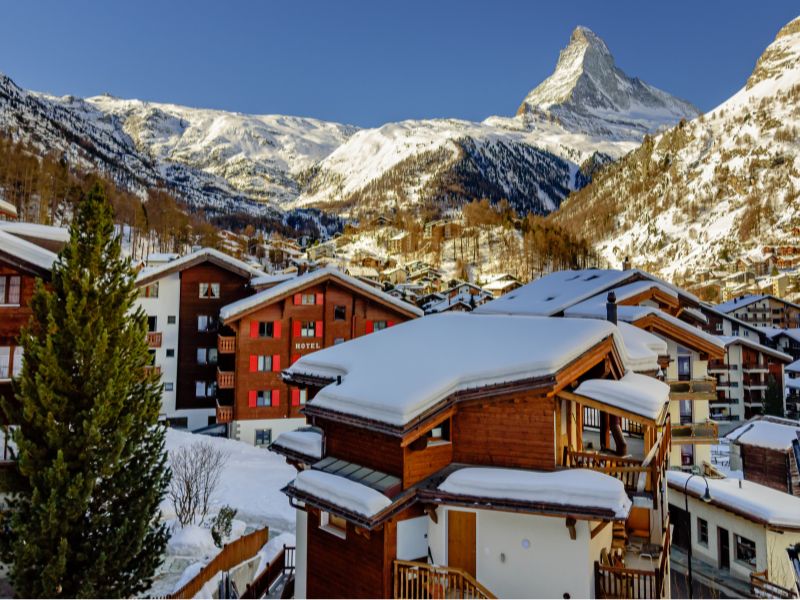
Where To Visit After Your Trip To Aosta?
After immersing yourself in the historical and natural wonders of Aosta, Italy, consider extending your journey to explore more of Italy’s diverse landscapes, rich cultural heritage, and exquisite cuisine. Here’s a curated list of destinations that promise to enrich your Italian adventure.
1. Turin
Just a short drive from Aosta, Turin, the first capital of Italy, offers an elegant mix of baroque architecture, prestigious museums, and renowned culinary traditions. Don’t miss the Egyptian Museum, one of the most important of its kind outside Egypt, or the National Museum of Cinema housed in the iconic Mole Antonelliana. Turin is also the birthplace of the Slow Food movement, making it a haven for foodies. Its grand piazzas and arcaded streets invite leisurely exploration.
2. Milan
As Italy’s fashion and financial capital, Milan is a dynamic city that blends modern innovation with deep-rooted cultural heritage. Marvel at the gothic Duomo, visit the world-renowned La Scala Opera House, and view Leonardo da Vinci’s “The Last Supper” in the Santa Maria delle Grazie convent. Milan is not just about fashion and art; it’s a city with vibrant nightlife and an impressive dining scene. Its proximity to lakes Como and Maggiore makes it a perfect base for exploring northern Italy’s lake district.
3. Lake Como
Nestled in the foothills of the Alps, Lake Como is known for its dramatic scenery, set against a backdrop of mountain peaks and lush gardens. Explore elegant villas along the lakefront, enjoy boating or windsurfing on the lake, and visit charming towns like Bellagio, Varenna, and Como. Lake Como has long been a retreat for aristocrats and the wealthy, offering a glimpse into luxurious Italian lakeside living. It’s an ideal destination for relaxation, outdoor activities, and soaking in breathtaking views.
4. Genoa
Venture to the Ligurian coast to discover Genoa, a city with a rich maritime history, renowned for its historic center, one of the largest in Europe. Explore the winding alleys (caruggi) that lead to majestic palaces, vibrant squares, and hidden gems. Visit the Aquarium of Genoa, one of the largest in Europe, and savor fresh pesto, a local specialty. Genoa serves as a gateway to the Italian Riviera, including the picturesque Cinque Terre.
5. Cinque Terre
The Cinque Terre, a UNESCO World Heritage site, is a string of five centuries-old seaside villages on the rugged Italian Riviera coastline. With colorful houses and vineyards clinging to steep terraces, hiking trails with stunning sea views, and harbors filled with fishing boats, it’s a picture-perfect slice of Italian charm. Enjoy local Ligurian cuisine, explore the villages by train or on foot, and relax on pebbled beaches. It’s a destination that beautifully captures the essence of coastal Italy.
6. Venice
Experience the magic of Venice, a city built on water, where gondolas glide through a maze of canals, and historical splendor meets artistic brilliance. Visit iconic landmarks like St. Mark’s Basilica and the Doge’s Palace, explore the vibrant art scene at the Biennale, and lose yourself in the enchanting alleyways and bridges. Venice is not only about its picturesque canals but also about its rich history as a powerful maritime republic. It’s a must-visit for its unique urban fabric and cultural heritage.
7. Verona
Just a stone’s throw from Venice, Verona is a city of romance, famously known as the setting of Shakespeare’s “Romeo and Juliet.” Beyond its literary connections, Verona boasts impressive Roman ruins, medieval architecture, and vibrant piazzas. Don’t miss the chance to visit Juliet’s House, the Roman Arena, and enjoy the local Valpolicella wines. Verona combines a rich historical tapestry with the charm of small-town Italy.
8. Dolomites
For nature lovers and adventure seekers, the Dolomites offer breathtaking mountain landscapes, outdoor activities, and UNESCO World Heritage status. Whether it’s skiing in the winter, hiking or cycling in the summer, or simply enjoying the panoramic views from a mountain hut, the Dolomites provide a spectacular natural playground. The region is also known for its distinctive Ladin culture, with unique traditions, languages, and cuisine. It’s an ideal destination for those looking to explore Italy’s alpine beauty.
9. Florence
Dive into the heart of the Renaissance in Florence, where art, architecture, and history come alive. Home to masterpieces by Michelangelo, Leonardo da Vinci, and Botticelli, the Uffizi Gallery and the Accademia are must-visit museums. Florence’s stunning Duomo, the Ponte Vecchio, and countless other historical sites make it a cultural pilgrimage site. The city is also a gateway to exploring the Tuscan countryside, known for its picturesque landscapes and exquisite wine.
10. Rome
No trip to Italy is complete without visiting Rome, the Eternal City. From the ancient ruins of the Roman Forum and the Colosseum to the Vatican City with St. Peter’s Basilica and the Sistine Chapel, Rome is a living museum of history and art. Enjoy the lively atmosphere of the city’s piazzas, indulge in Roman culinary delights, and explore centuries of history in one of the world’s most fascinating cities. Rome offers an unparalleled blend of culture, history, and lifestyle.
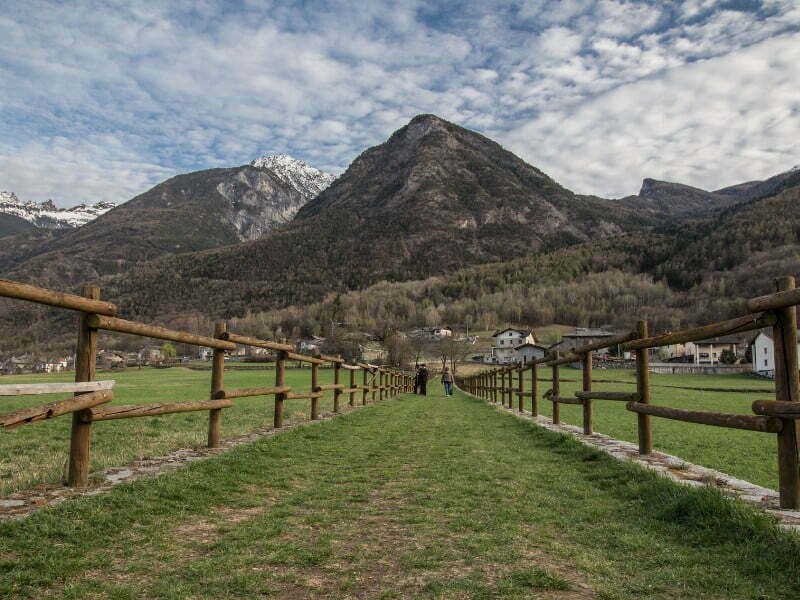
Aosta Travel Guide: Final Thoughts
Aosta, with its rich tapestry of history, culture, and natural beauty, has a way of capturing the hearts of those who wander its cobblestone paths. Let’s reflect on the essence of this enchanting city nestled in the Italian Alps and why it promises a return visit.
The Heartbeat of History
Walking through Aosta is akin to traversing through time. The Roman ruins that stand stoically against the backdrop of snow-capped mountains remind us of the city’s ancient roots. The stories encapsulated within the walls of its castles and the whispers of the past in the old town’s alleys offer a profound connection to history that few places can. Aosta doesn’t just tell you its past; it lets you live it, breathe it, and walk through it.
Nature’s Grandeur
The natural beauty surrounding Aosta is nothing short of breathtaking. Whether it’s the serene landscapes of Gran Paradiso National Park or the awe-inspiring views from the Skyway Monte Bianco, the region offers an endless canvas of nature’s artistry. It’s a paradise for outdoor enthusiasts, offering skiing, hiking, and simply the joy of being amidst pristine nature. The changing seasons each bring their own charm, painting the valley in different hues and offering new experiences with each visit.
Culinary Delights
Aosta’s cuisine is a delightful journey through the flavors of the Alps. From Fontina cheese to the hearty Valle d’Aosta Jambon de Bosses, the local fare is a testament to the region’s rich culinary heritage. Pair these with a glass of local wine, and you have a feast that celebrates the bounty of the land. The warmth of Aosta’s dining is matched only by the hospitality of its people, making every meal a memorable experience.
A Cultural Melange
What truly sets Aosta apart is its vibrant culture, a blend of Italian, French, and Alpine influences that’s reflected in its language, traditions, and festivals. The city’s calendar is dotted with celebrations that bring to life the customs of the valley, offering a glimpse into the local way of life. From the Sant’Orso Fair to the music festivals that echo through the mountains, Aosta’s cultural landscape is as diverse as it is rich.
So, until we meet again, Aosta, keep your ancient stories and alpine wonders close to your heart, ready to share with those who seek your hidden treasures. Your beauty, history, and culture remain an open invitation to explore, experience, and cherish.
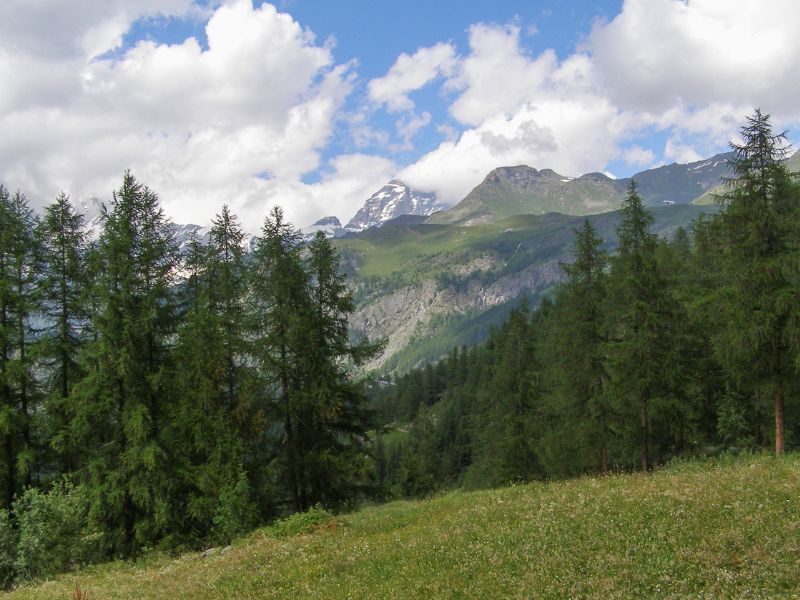
Ode To Aosta
In the heart of the Aosta Valley’s embrace, Lies a town of beauty, full of grace. Aosta, ancient and steeped in history, Invites travelers to unravel its mystery.
Roman ruins whisper tales of the past, The Arch of Augustus, a majestic contrast. Stroll through streets where time stands still, Marvel at the architecture, an artist’s skill.
Surrounded by mountains, mighty and grand, Aosta’s beauty is a sight to understand. Peaks touch the heavens, snow-capped and true, A stunning backdrop, forever in view.
Step into the past, walk the cobbled lanes, Feel the spirit of ancient Rome’s remains. The Roman Theater, a stage of long ago, Whispers echoes of stories, of dramas that flow.
With every step, history unfurls, The charm of Aosta, a gift it hurls. Narrow alleys, lined with quaint abodes, Reveal secrets, as ancient stories explode.
Mountains beckon, calling adventurers near, To Gran Paradiso, where nature’s treasures appear. Hiking trails wind through landscapes serene, Where wild beauty reigns, untouched and pristine.
Taste the flavors that Aosta bestows, Fontina cheese, carbonade, culinary heroes. Savor the warmth of polenta, golden and fine, And wines that dance on your tongue like sweet rhyme.
Hospitality embraces every traveler’s stay, Aosta’s people, welcoming in every way. Their warmth and smiles, a genuine embrace, Making Aosta a haven, a magical place.
As you depart, carry Aosta’s spirit in your heart, Its history, beauty, and warmth, never to depart. Aosta, a treasure in the valley’s embrace, Forever etched in memories, a traveler’s grace.
